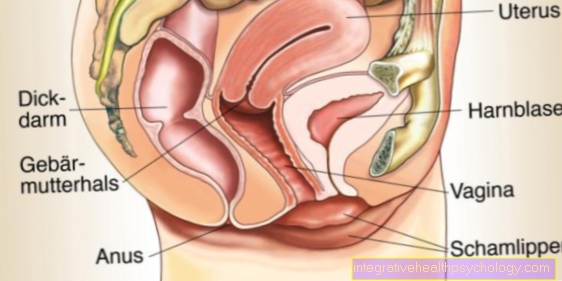Femoral catheter
definition
A femoral catheter is an access to the femoral nerve through which pain medication can be administered (also continuously). These painkillers are directed into the immediate vicinity of the nerve and prevent the perception of pain from being passed on. It is a method of short or long-term pain therapy. Other names for the femoral catheter are "Femoralisblock" or "Nervus-Femoralis-Blockade".

Indication for a femoral catheter
The femoral catheter is usually used to treat pain during or after operations. The primary goal here is of course to expose the patient to as little pain as possible. Like all nerves, the nervus femoralis has its own innervation area. In the case of the femoral nerve, this area is down from the hips, i.e. a large part of the legs. For this reason, the femoral catheter only makes sense when numbing regions that are below the hip and are innervated by the femoral nerve.
Procedure and implementation - how is it laid?
The placement of a femoral catheter proceeds as follows: The patient lies on his back and has his leg, on which the operation is taking place, in a slightly splayed and outward position. This enables the anesthetist to easily reach the femoral nerve. The anesthetist then pierces the skin with a puncture cannula. The puncture site is to the side (away from the center of the body) of the femoral artery, which can be felt. As soon as the puncture needle is in the skin, a nerve stimulator or ultrasound is used to search for the femoral nerve. If the stimulator is near the femoral nerve, visible muscle twitching occurs in the thigh. The key muscle of the femoral nerve, the Rectus femoris muscle (also called quadriceps). The movement of the kneecap can also be observed. If necessary, the anesthetist shifts the puncture needle minimally in order to find the point of the strongest stimulus response. From this it can then be concluded that you are in the right place and can start with local anesthesia.
Alternatively, ultrasound can be used to monitor the puncture of the nerve. The catheter is then pushed a little over the puncture needle so that it remains on the nerve. In the case of short-term anesthesia, the pain reliever is then given through the catheter and then removed.
In the case of an indwelling catheter, the puncture needle is removed and the femoral catheter is attached to the skin via a skin suture. This prevents it from slipping out. Finally, the puncture site is covered sterile and painkillers can then be fed to the nerve via the indwelling catheter.
How painful is it to lay it?
Local anesthesia is performed before puncturing the femoral nerve. Due to the anesthesia, the patient has no pain when the anesthetist searches for and punctures the nerve with the help of the puncture needle. All in all, the pain of the procedure can be reduced to a small poke through the anesthetic.
Risks
The risks of femoral nerve block are very manageable. This is a routine measure, which in most cases runs smoothly. Nevertheless, cardiovascular problems and nerve damage should be mentioned as risks, which however occur very rarely.
Complications
As a complication, for example, the nerve can be injured when puncturing with the puncture needle.
In addition, the local anesthetics can be directed into the nerves, which can lead to cell damage in the nerve. This damage to the nerve can have different degrees of severity. Depending on how severe the damage is, it can lead to long-term failure of the muscles and sensitivity.
There is also a possibility that the pain reliever may be directed into the blood vessels. The anesthetic also reaches the heart from these blood vessels. This can lead to cardiac arrhythmias. This can lead to a reduced heart rate (Bradycardia) and decreased blood pressure (Hypotension) come. Because of this, however, the blood pressure, heart rate and oxygen saturation are monitored during the procedure.
Read more about this under Cardiac arrhythmias
Side effects of a femoral catheter
The usual side effects of local anesthesia should be mentioned as side effects.
A necessary and expected side effect is the failure of the muscles innervated by the femoral nerve during treatment. In particular, stretching the knee will not be possible. Bruising after the puncture is also less of a side effect.
How long does it work?
How long the femoral block works depends very much on the dose of local anesthetic. A certain amount of local anesthetic is given through the catheter, which the doctors adjust to the duration of the procedure. If it is an indwelling catheter through which a local anesthetic can be administered continuously, the famoralis block has an unlimited duration of action. Of course, only on the condition that local anesthetics are given permanently.
Catheter length of stay
The length of time the femoral catheter remains in place, just like the duration of its action, depends on the type of procedure. If it is only a short-term anesthetic for a minor operation on the leg, the local anesthetic is administered once via the femoral catheter. The catheter is then pulled out.
However, if it is a long-term pain therapy after a major operation, the catheter is usually in place for several days to ensure continuous anesthesia of the wound.




























